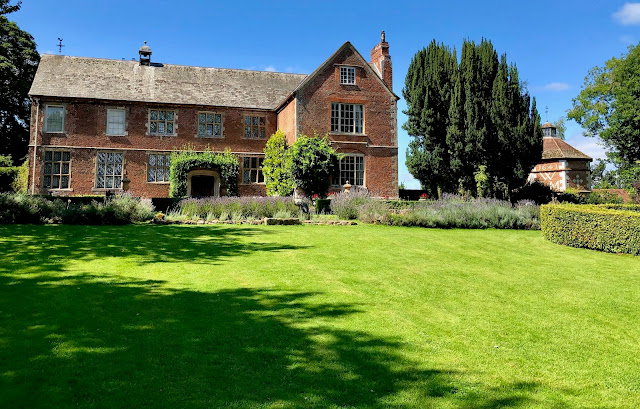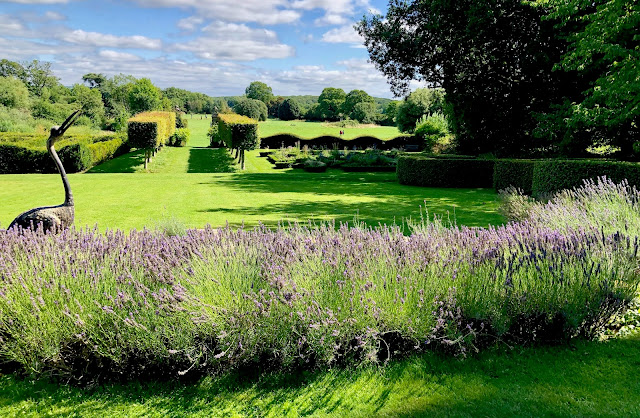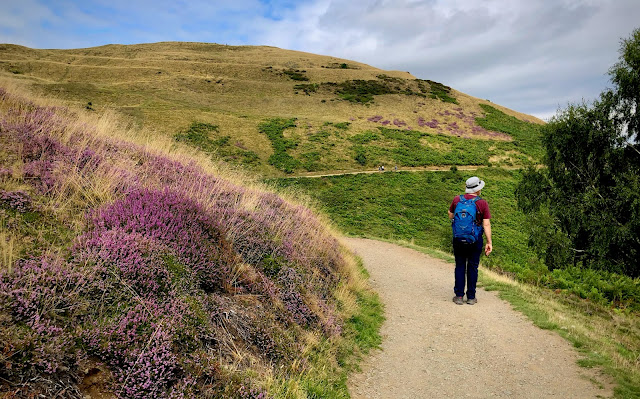 |
Field just down the hill from Frensham Heights School, at sunrise.
This is one of the glorious views to which I'm privy as I take my early morning run each day |
Greetings, all.
Those of you who know me even superficially will be aware that summer is my least favourite season. One of my oft-quoted mantras is that 'If I never have another day above 15ºC it will be too soon.' People here in the UK often marvel at our decision to leave the comparatively endless summer weather of Australia for this green and pleasant land, to which I respond that after the best part of five decades suffering through extreme heat and decade-long droughts, I've had enough sun and warm weather to see me through the rest of my life.
But I have to say that living in Surrey for many years now, summer does not inspire quite the same level of dread as it used to in Australia. With climate change we are experiencing more heat of course, and in fact it's doubly hard to cope with heatwaves here as the buildings are simply not designed for hot weather - there are no awnings to protect walls and windows from direct sun; often windows and doors don't line up to provide cross-ventilation; air conditioning is rare, confined mainly to cinemas (remember those?), shopping malls, modern office buildings and the odd café or restaurant... although most British people don't seem to understand that you need to keep doors and windows closed for air conditioning to have any effect.
Plus, summer days in the UK are L-O-N-G. It's geting light by 4am and twilight stretches to 10pm even down here in the south. Heatwaves tend to last at least a week and believe me, brick buildings without awnings and air conditioning store up a lot of those lengthy hours of sunshine, guaranteeing sleepless nights as the heat is released back out of the bricks.
 |
| Morning mist with horses - in a field near the school |
All the same, those weeks are thankfully infrequent; we usually get only a couple of periods of really hot weather between April and September. The rest of summer is blissfully mild by Australian standards and the lush glories of an English summer are something to behold. After a lifetime of distress gazing out over a brown, dry, dusty environment and passing fields with poor cows and sheep at the mercy of the blazing sun (no shelter required under Australian law - barbaric), I will never take for granted the gobsmacking, rich green of England.
Add to this the vast array of publicly accessible gardens... the delights are endless. You could keep busy for months visiting National Trust properties, private estates, and the properties of 'ordinary folk' opening their gardens for charity as part of the National Garden Scheme. The photos below are of Stuart Cottage, one of the NGS homes recently open to the public, in nearby East Clandon (about a 30 minute drive from home). It's one of the loveliest NGS open gardens we've ever visited, and what's more they provided free tea and cake - a truly lovely afternoon tea experience!
 |
Just one of the gorgeous sections of garden at Stuart Cottage in nearby East Clandon
(participating in the National Garden Scheme) |
 |
| Dahlia 'Honka Fragile' - one of the many lovely blooms at Stuart Cottage, East Clandon |
 |
| Lavender going gangbusters at Stuart Cottage, one of the NGS open gardens, in East Clandon |
 |
| Spectacular hydrangea paniculata 'Limelight' in the front garden of Stuart Cottage, East Clandon |
 |
| Flourishing pyracantha at the front entrance of Stuart Cottage, East Clandon |
You've got to hand it to the Poms; despite the unpredictability of summer they embrace outdoor activities with gusto and a hefty dose of stoicism. Way back in April I grasped uncertainty with both hands and booked tickets for us to attend an outdoor theatre performance at nearby Chawton House, the former home of Jane Austen's brother and a place I tend to visit several times a year. It is a truly delightful village, which I have noted in several blog posts. I doubled the risk of inclement weather by inviting good friends Roy and Tracey to travel down from Buckinghamshire to join us.
The weekend approached with a less than encouraging forecast for heavy rain on Saturday evening, but we bravely packed our picnic, drove over and spread out on Chawton House's lawn with the other hardy folk, determined to enjoy Oscar Wilde's The Importance of Being Earnest even if it bucketed down. In fact the weather gods were kind to us, and after a period of threatening black skies culminating in a couple of minutes of drizzle, the skies miraculously cleared to give us a beautiful but chilly evening with a beautiful sunset.
 |
Theatre troupe Slapstick Picnic did a fantastic and quirky performance of Oscar Wilde's
The Importance of Being Earnest in the grounds of Chawton House, Hampshire |
 |
| We dodged the heavy rain (but only just) - take a look at those black skies! |
 |
| The spires of St Nicholas' Church at sunset, adjacent Chawton House |
In early August we revisited National Trust property Nymans, after an absence of many years. Located just south of Crawley in West Sussex, it really is one of the nicest properties in the NT portfolio in my opinion, particularly the garden which is just magnificent - truly. This, despite losing 486 mature trees in the Great Storm of October 1987 (and I imagine some of you are now smiling in recollection at a particular episode of The Vicar of Dibley).
The house was completed in 1928, constructed in 'mellow' late Gothic / Tudor style. The building is particularly interesting in that half of it was destroyed by a fire in 1947, and was never restored - mostly due to the shortage of building materials immediately after the Second World War, but I think perhaps finances were also an issue. Thereafter the Messel family used Nymans simply as a base for enjoying the grounds. The result is that part of the house remains a ruin, and the rest is a warm and cosy dwelling that you could imagine living in without too much effort.
 |
| National Trust property Nymans, in West Sussex |
 |
| Nymans is known for its many and varied plants, including spectacular hydrangeas |
 |
| Massed hydrangea at the entrance to the Wall Garden |
 |
| The rustic interiors of Nymans House, West Sussex |
 |
Family photos adorn the top of the Broadwood piano (1881) in The Garden Hall.
At the time of our visit a National Trust volunteer was playing the instrument for the enjoyment of visitors -
we were fortunate enough to be there for a rendition of one of my favourite pieces, Beethoven's Moonlight Sonata |
 |
| Historical garden catalogue in The Garden Hall |
 |
| As you might know, I do love a bit of topiary! |
 |
| How gorgeous is the dovecote at Nymans? Such a romantic bit of architecture |
 |
Summer's floral abundance in The Wall Garden at Nymans
(not a typo - it is The Wall Garden, not 'walled') |
 |
| One of sections of the house destroyed by fire in 1947 at Nymans, West Sussex |
 |
| Fabulously ornate garden bench in the courtyard outside the main entrance to Nymans |
The season for visiting gardens is nearing its end so a couple of days ago, on the always reliable advice of Lesley, I booked to visit Parham near Pulborough, West Sussex, a privately owned estate which is only open four days per week as it's a family home. I particularly love the Petworth region of West Sussex (Pulborough is only about 10 minutes from Petworth itself), and Parham has cemented that appreciation.
The estate spreads across 300 acres of ancient deer park, with today's fallow deer the descents of the original herd first recorded in 1628. Surrounded by gorgeous green hills, there are seven acres of Pleasure Gardens to explore, originally laid out in the 18th century. At this time of year the gardens are of course starting to fade, but there was still plenty to admire. And rarely have I come across grounds that have so many appealing nooks and crannies in greenhouses, follies and summer houses.
Like many historic homes in England, the building has been extended throughout the centuries but the oldest part is Elizabethan. The interior is absolutely gorgeous with gigantically tall mullioned windows meaning it is a light-filled space. Additionally, because this is a lived-in home, there's none of that National Trust keep-the-curtains-drawn-and-make-the-visitors-stumble-around-in-the-dark malarkey. Of course I appreciate the need to conserve fabrics, wallpapers etc but when the light is so dimmed that you can barely see anything... it's disappointing, to say the least.
The upper level houses a spectacular Long Gallery (nearly 50 metres) with its hand-painted, barrel-vaulted ceiling. Plus... The paintings! The furniture! The tapestries! The superb arrangements of fresh flowers from the garden! Once again Lesley's advice proved to be sound and I will happily visit Parham again, perhaps in spring. I've tried to curate the photos but it's too difficult, so following are (probably) way too many glimpses of Parham.
 |
| Parham, near Pulborough in West Sussex |
 |
| The Long Gallery with its 50-metre barrel-vaulted ceiling at Parham, West Sussex |
 |
Detail of the hand-painted, barrel-vaulted ceiling in The Long Gallery
- Parham, West Sussex |
 |
Portrait by Juan Pantoja de la Cruz, at Parham in West Sussex
- unfortunately I can't find out the name of the subject! |
 |
| Some of those gigantic mullioned windows in The Great Hall at Parham |
 |
Inside The Great Hall at Parham, West Sussex.
The Victorians apparently painted or dark-waxed all the original oak panelling, but when the Pearson Family
acquired the house in the 1920s, they painstakingly stripped it back to its original 16th century form |
 |
| Every room in Parham is adorned with beautiful arrangements from the extensive gardens |
 |
| The Three Arched Summer House at Parham, West Sussex |
 |
| Detail of a sculpture by Ivan Meštrović, inside the Three Arched Summer House at Parham, West Sussex |
 |
| An atmospheric little corner at Parham - at the entrance to The Greenhouse |
 |
The Wendy House at Parham, West Sussex
(for non-British readers, a wendy house is a cubby-house, ie a small-scale house for children to play in) |
 |
| Helianthus annuus 'Goldy' double sunflower - inside the walled garden at Parham |
 |
| Raindrops look like diamonds on the leaves of continus 'Royal Purple' - in the walled garden at Parham |
 |
| A cosy nook at the entrance to the greenhouse, Parham |
 |
| The Dovecote, Parham in West Sussex |
 |
| Fig tree outside The Mower Shed café at Parham, West Sussex |
 |
| The Courtyard and carriage arch, opposite the house at Parham, West Sussex |
Some of you might recall that in May I blogged about the 15th anniversary of my mother's passing. In that post I lamented the fact that two kitchen hand towels made by Mum were nearing the end of their usefulness, almost transparent through 17 years of constant use and laundering. That post was read by one of Mum's oldest and dearest friends, a woman I was named after - Maree Abbott. I met Maree a few times throughout my life and after Mum's death we struck up a correspondence. She is another of that generation's amazingly clever and handy women, still creating patchwork quilts and other handcrafts in her eighties.
A couple of months after I published that blog I received a parcel in the mail from Maree, containing two kitchen hand towels that had been lovingly sewn by her, to replace the ones from Mum. A short note said how much Maree had enjoyed my blog, and she had created the hand towels in remembrance of Mum. I confess to being moved to tears, and will treasure Maree's gift as I treasured the towels given to me by Mum all those years ago.
 |
A beautiful handmade gift from one of Mum's dearest friends, Maree Abbott
|
The two photos immediately below are of our neighbour in her garden, Miss Pickle, whom we have been delighted and privileged to look after a few times over the summer, when her humans had to travel away.
The third shot is of this year's clutch of baby pheasants learning to peck for seed on our terrace - all ten of them!
 |
| Miss Pickle in one of her favourite sports in her garden |
 |
| Miss Pickle assisting me with my reading |
 |
| One of the Mrs P's, with her brood of TEN newly-hatched chicks |
This has been a fairly mild summer, with just a couple of periods of really hot weather and during August I was lulled into a false sense of security - temps mainly in the low 20s, and quite grey and humid. *Blam!* The first week of September had us in a mini heat wave, with three days of 30ºC. I'm hoping that's summer's last hurrah.
 |
| Early morning light on the lane at the bottom of the hill below our house |
 |
| Sunrise over the lawn - Frensham Heights School |
I have one last 'summer' garden visit booked for next weekend - National Trust property Woolbeding Gardens, again in West Sussex. And of course then I have the delights of autumn to look forward to - already the leaves are starting to turn, we have picked a couple of kilos of blackberries (which are superb this year - plump and juicy), and the days are drawing in. Hip, hip, hooray! Onwards towards winter...
Until next time,
- Maree xo










































































